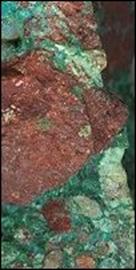|
(The image to left is an old graphic of a cowry shell with its venting spouts for moving about in water. Cowry shells were considered as part of ancient Chinese peoples valuables and this graphic became part of their most common character ,”Pao”, found on almost all their coins from the Tang dynasty to the Last Emperor.)
Before I go on to my favorite collection of Chinese cast coins I have a little to share so a better understanding of such coins is presented.
Firstly I would like to write a little about the mineral copper. In the Pre-History section, a few facts about mining and smelting in ancient times will be touched on. The three Old World Cultures and their different minting methods are briefly written about. Lastly addressed, why do copper pennies tarnish brown after only one year and why do ancient copper coins in general have this peculiar surface (patina) and should I do anything about it? |
|
Beginnings |

|
1. The Mineral Copper |

|
The mineral copper was one of the first metals known to man. It has been used by human beings for at least 7000 years. Our word copper and the chemical symbol for the element, Cu, came from cuprum, the Roman’s name for Cyprian Metal as the island Cyprus was a major source of copper for the ancient Mediterranean world. |

|
Copper (Cu) is a metallic element. It is capable of being hammered out thin , to undergo change of form without breaking and of being molded or shaped. In moist air it forms a patina, a protective brownish to greenish surface. Film. A chief commercial use since ancient times is as an alloy in coins. Copper alloys include bronze. Bronze is an alloy of copper with up to 25% tin. Phosphorous, lead, zinc and sometimes small amounts of other elements may be added for special purposes. It is harder than brass and its properties depend on the proportions of its components. One use for bronze is for coins. |
|
Raw copper ore in nature most frequently occurs as a sulfide such as Chalcopyrite. Chalcopyrite is brassy yellow and sometimes with an iridescent tarnish. It is found in crystal form but is most often massive. Chalcopyrite is found world-wide. It is a principal ore composed of copper and iron sulfide mineral, but exposure to water and oxygen causes it to oxidize and to combine with other minerals such as carbonates. The copper in these minerals has to be removed by smelting processes before the copper metal can be worked. |
|
The other copper mineral sources of the ancient world included: Cuprite: A copper material having a dark ruby red or purple color, which has a combination of copper and oxygen; Malachite: A hydrous copper carbonate having a vivid green color, and; Azurite: Another hydrous copper carbonate having a dark blue color. These are all fairly low melting ores. However they all require the use of a fire which is considerably hotter than that used for normal cooking. Copper metal melts at 1084 degrees C. |
|
2. Pre-History Stone Age The earliest known period of human culture which is marked by the use of stone tools. Bronze Age A period of human culture between the Stone Age and the Iron Age marked by the use of bronze implements and weapons. It is not a particular date of time. The Bronze Age in any region usually overlapped an earlier Stone Age and a later Iron Age, because people didn’t stop using one material all at once and switch to another. The earliest known use of bronze occurred in Sumer, Mesopotamia, about 3000 B.C. Iron Age The prehistoric period succeeding the Bronze Age marked by the introduction of iron metallurgy. In Europe this is around 8th Century B.C. |
|
A. Mining, Prehistoric Copper Recovery In many areas of the world copper was found as grains and nuggets among ordinary sand and gravel like deposits especially in rivers, river deposits and beach sands; and as nuggets and masses on the surface of the earth, adjacent to streams and in the walls of canyons.
These initial sources were copper metal, which had a distinctive reddish brown color. The ancients soon found that the malleable metal could be beaten into the shape of crude weapons, ornaments and domestic utensils. It is possible that people making pots on open fires first found that if the copper metal ore was first heated it became less brittle and easier to work. This process is known as tempering. The edge on a tool or weapon after tempering was harder and more durable. This was the first transition from the Stone Age.
The discovery of bronze and its usefulness in making tools and weapons increased the demand for copper. It was no longer possible to supply the demand from just surface won copper metal and ore. Other methods of finding copper were required. This led to the development of primitive mining techniques.
It is likely that the first mines were simply people digging down from surface deposits of known copper yielding ores. These shallow surface pits - called bell pits - were dug using stone, copper or later bronze implements. Crude picks, hammers, chisels and shovels would have been used.
Some of the earliest organized mines date back to the early Bronze Age. In a mountainous area in northeast Serbia, which was a part of old Yugoslavia, a well-preserved example of a large underground copper-mining industry was discovered in 1968 near Rudna Glava. It is about 170km east of Belgrade and 30km north of Bor. This site is a well-preserved example of mining sites that were rather widespread in the Balkans around 4500--4000 B.C. The miners were exploiting first surface copper; and then malachite (copper carbonate ore) as they followed ore veins deep into the ground.
The ancient shafts where up to 20 meters (70 feet) deep, and mark the points where the miners followed veins of copper ore downward from their surface discovery, to the level at which they met ground water. The rock was too hard for the primitive tools of the day so miners used fire setting. Logs were piled against the rock face and a fire set. The rock face was heated to high temperatures and then water was poured onto it. The sudden change in temperature caused the rock to shatter making recovery easier.
Once brought to the surface, the rock blocks of ore were pounded into small pieces with stone hammers. This was sufficient preparation for copper smelting. |
|
B. Copper Smelting In Anatolia there was not the abundant supply of native copper as elsewhere. After the first native copper had been worked out , copper had to be extracted from copper-bearing minerals by smelting. Smelting is not to be confused with melting. Smelting is the process by which fire is used to extract metal from ores such as copper-oxides, -carbonates or -sulfides.
We do not know how copper smelting was discovered. There are two plausible pathways for the discovery of smelting, both of them involving pottery kilns. The presumption is that someone discovered accidentally that certain stones produced molten metal if they were used in building a campfire. However, most campfires are small, open and short-lived. They burn at best around 600° or 700° C and hardly ever produce the right oxygen-starved conditions for smelting, so this is not likely the true story. It was more likely happened upon while doing something else. For example, the vivid green copper ore malachite must be heated in an oxygen-starved fire before molten copper beads are formed.
Probably around 9000 BC, in western Asia, the discovery of pottery for beakers was made. It is a likely scenario that pottery making was followed relatively quickly by the use of metals. Firing clay into useful pottery demands the careful production of high temperatures inside a kiln. Pottery kilns can reach much higher temperatures than open fires, and they operate somewhere near the boundary between sufficient oxygen and oxygen starvation. Properly loaded, kilns can maintain temperatures above 1000° C for hours, in an oxygen-starved atmosphere, much closer to the melting point of copper. Firing to about 450° C makes pottery hard and waterproof, firing to 1400° C makes the pot shiny and even harder, and at this temperature can smelt metal out of an ore.
In the Middle East the remains of open hearths, an early form of a simple kiln, have been found. These were holes in the ground about two feet in diameter. They were lined with fire resistant clay bricks. Charcoal was placed in a layer on top of the clay bricks. The copper ore then covered the charcoal. Charcoal burns with a very hot temperature, which was sufficient to melt the copper ores. It also releases gasses, which reduce the copper in the ore back to the metallic state. A heavy molten mass of copper formed and the charcoal reacted with the matrix of stony and earthy minerals in the ore to form a lighter molten slag. The hearth was allowed to cool and the metal and slag separated.
A later, more complex method was developed which used the crucible. This was a ceramic pot into which charcoal and the copper ore were placed. The crucible was placed in a furnace where bellows made from skins directed air to raise the temperature in the furnace. The charcoal and copper ore in the furnace reacted in much the same way as in the open hearth to produce copper metal and slag.
It is likely that smelting to recover the copper also lead to the discovery of casting when liquid metal was poured into molds. Copper ingots were cast into shapes of bars and rings at the mines for transport to the centers of commercial activity. It also allowed the mixing of metal to form alloys. Eventually it was discovered or recognized that mixing copper with tin made the harder material, Bronze. It may well have been first impurities left in copper and then later deliberately added. |
|
310 |